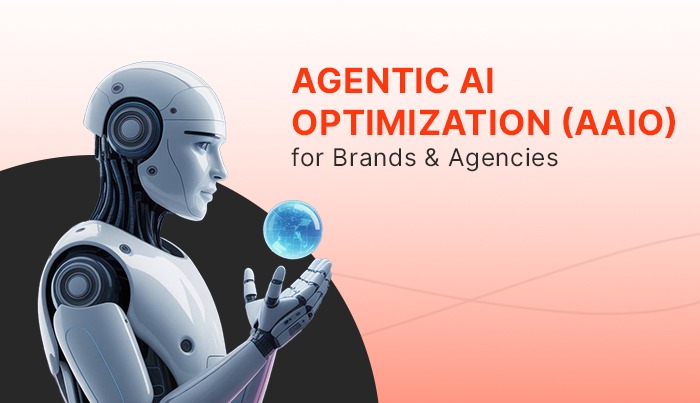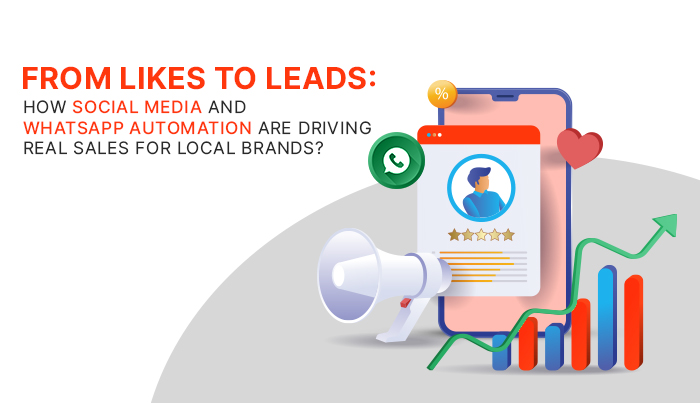Agentic AI optimization (AAIO) for brands & agencies
The next chapter of digital marketing will not be written for humans alone. It will be written for machines that think, act, and decide on behalf of humans.
We call them autonomous AI agents — systems that browse, compare, and choose products independently. For brands and agencies, the question is no longer how to attract customers online, but how to be found and favoured by AI agents.
According to MIT Technology Review, autonomous agents are becoming an important part of the online world and are changing how people find and choose brands.
That is the foundation of Agentic AI Optimisation (AAIO) , the emerging discipline of optimising for AI agents, where brand strategy, design, and content are built not just for people but for digital intermediaries that make choices on their behalf.
What Is Agentic AI in Digital Marketing
Agentic AI simply means systems that can think and act on their own, without needing step-by-step instructions from people. You can think of everyday examples like Alexa, Google Assistant, or what ChatGPT could soon become — tools that don’t just answer questions but actually do things for you. They can book a table, compare flight prices, or choose a product that fits their preferences.
In this new reality, marketing isn’t just about convincing people anymore. It’s about making sure these AI systems recognise, trust, and recommend your brand when they’re the ones doing the choosing. The real goal is to help these AI systems understand what makes your brand trustworthy and relevant to what people actually want. That’s what agentic AI optimization is really about: making sure that when an AI goes looking for the best option, it naturally sees your brand as the one that fits.
Why Brands Need to Prepare for AI-Driven Customer Journeys
The traditional customer journey is collapsing. Consumers no longer browse dozens of options; they rely on AI to shortlist what’s best. The rise of AI marketing automation has already changed how ads are served and campaigns are run, but autonomous AI agents in marketing take it a step further — they act on behalf of users.
Imagine a digital assistant that orders groceries, books a flight, or subscribes to a new service after evaluating reviews, price data, and sustainability scores — all without the user visiting a website.
For brands, this means one thing: your visibility now depends on how well your data, content, and digital experience align with the decision frameworks of AI systems.
Optimising for AI Agents: What Changes
Most marketers understand SEO well, but optimising for AI agents requires a different way of thinking. It is not about chasing rankings anymore but about helping intelligent systems clearly understand and trust your brand.
Here is what that shift looks like:
- Be clear and structured.
- AI systems need information that is easy to read and logically arranged. Use clear product details, consistent labels, and accurate metadata so the system instantly understands what your brand stands for.
- Show your credibility
- These agents look for proof, not persuasion. Verified reviews, open pricing, sustainability information, and genuine mentions from trusted sources help them see you as reliable.
- Keep your voice consistent.
- While AI cannot feel emotion, it can recognise tone. A steady, authentic brand voice builds trust and helps the system match your content to user intent.
- Make the experience effortless.
- A quick, well-organised website does more than please visitors. It helps AI read, navigate, and interpret your content easily. Focus on clear menus, readable layouts, and logical flow.
- Design for both people and machines
- Every design choice now sends a signal to AI. A website that feels easy for humans to browse also feels clear for machines to understand.
In the end, visibility will depend on how well you combine clarity, consistency, and credibility. These qualities make people trust your brand today and will make AI agents trust it tomorrow.
Essentially, the new audience is both human and algorithmic. The brands that serve both seamlessly will lead.
Designing Websites for AI Assistant Interaction
Traditional web design focused on visual flow and human usability. The next evolution is UX for AI browsing — building websites that AI assistants can easily interpret and act upon.
This includes:
- Clear product definitions and categorisation.
- Rich semantic data, such as FAQs, specifications, and reviews embedded as structured markup.
- Conversational copy that mirrors the way AI assistants phrase queries.
When AI assistants crawl and summarise your pages, they look for precise, verifiable information they can present confidently to users.
Building Brand Strategy for AI Bots
In agentic AI optimization, brand strategy goes beyond storytelling. It focuses on building trust and credibility that machines can recognise.
A strong brand strategy for AI bots includes:
- Authority through verified insights or credible partnerships
- Consistency in tone, metadata, and messaging across all platforms
- Reputation data is managed actively through genuine reviews and feedback
The future of autonomous web agents will rely on these signals. Your brand must speak clearly to both people and the AI systems that interpret meaning through data and tone.
How to Build Brand Experiences for AI Agents
To understand how to build brand experiences for AI agents, think of them as both audience and intermediary. They are users’ digital decision-makers.
Your task is to create experiences that are:
- Readable
- Responsive
- Reputable
The more consistently your brand communicates these values, the easier it is for AI systems to rank you as trustworthy.
The Digital Strategy for AI Assistants
Your digital strategy for AI assistants should blend three disciplines — content architecture, structured data, and conversational design.
- Content architecture ensures that your core offerings and expertise are discoverable and logically arranged.
- Structured data makes your information machine-friendly.
- Conversational design helps your brand language fit naturally into AI-driven interactions.
When combined, these elements turn a standard website into a resource that AI assistants can use, reference, and even promote autonomously.
The Future of Autonomous Web Agents
We are on the brink of a new web layer, one where autonomous web agents act as the dominant interpreters of digital information. These smart AI agents will guide people at every step, from finding a product to buying it.
For brands and agencies, agentic AI optimization is the future of digital marketing where search, design, and content unite to guide both people and AI agents in marketing toward smarter choices.
Conclusion:
Agentic AI optimization is now the new normal in the digital marketing world. Agencies and businesses must adopt it quickly before their competitor does to ensure that they make most out of their early adoption.
Agencies need to rethink the basics like content, data, and design so they make sense to both humans and intelligent systems. Brands must create experiences that feel good to people and are easy for machines to understand.
The future will belong to those who earn trust through clarity, honesty, and genuine connection rather than those who chase attention.




